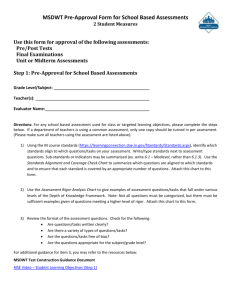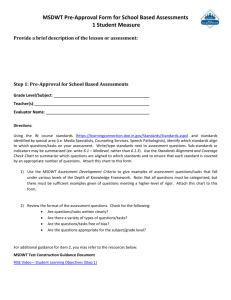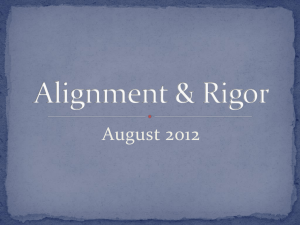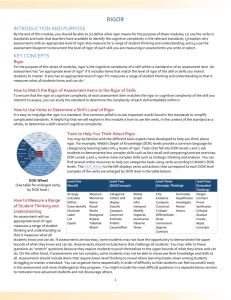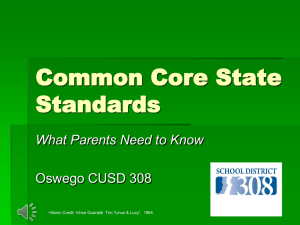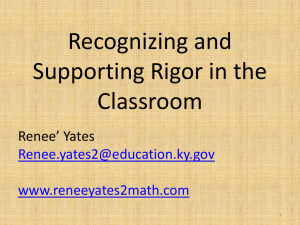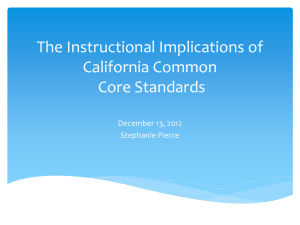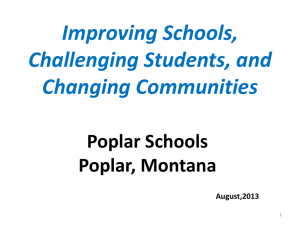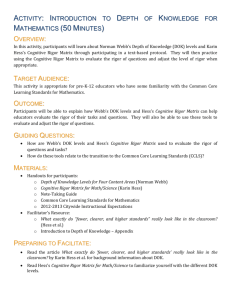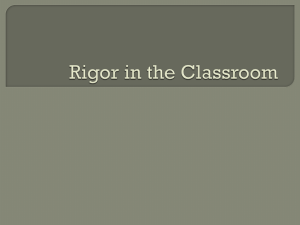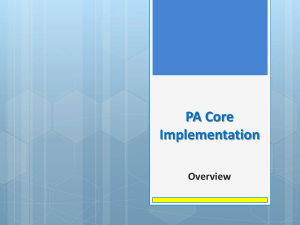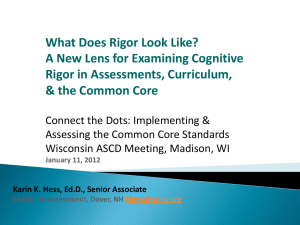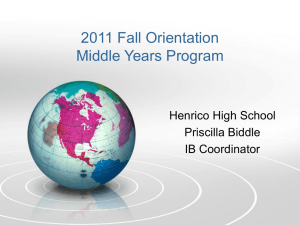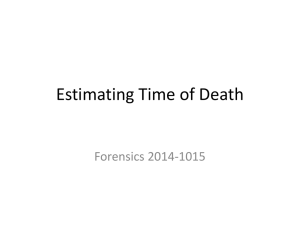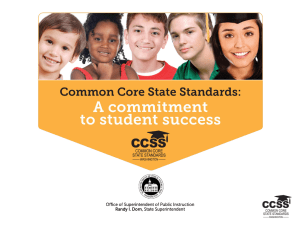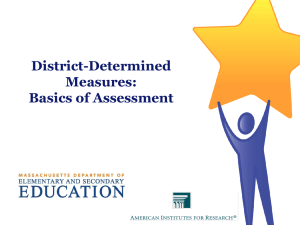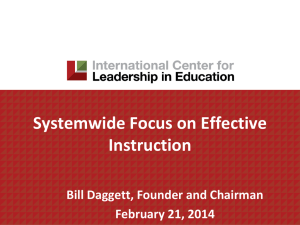File
advertisement
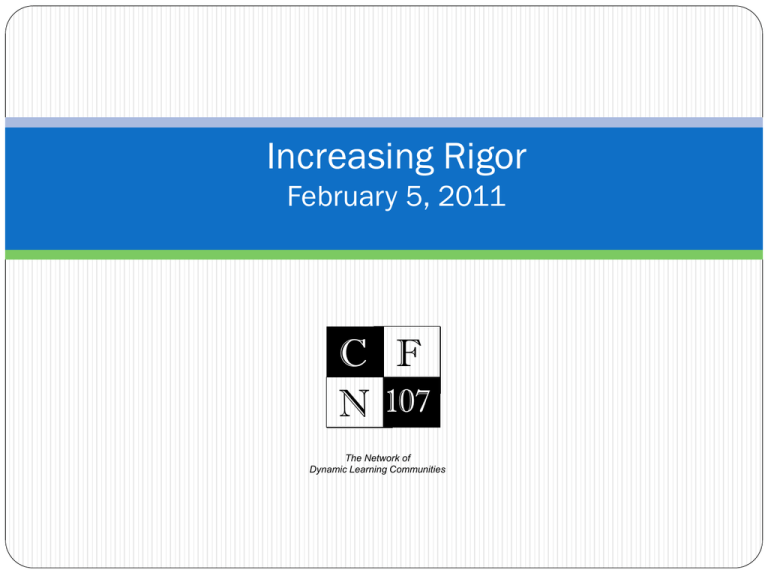
Increasing Rigor February 5, 2011 C F N 107 The Network of Dynamic Learning Communities Welcome! Grab some coffee and breakfast. Energizer: Non-Linguistic Representation of Rigor and Performance Assessment Find a table group where you will share your thinking and non-linguistic communication skills. Discuss how you define the question on your task card, either: • What is cognitive rigor? or • What is the relationship between cognitive rigor and performance assessment? Decide together how your group will illustrate the assigned question using a graphic model or picture with three words or less. 3 Common Assessment Practices Across Countries that May Influence CCSS Movement Assessments are part of a tightly integrated system of standards, curriculum, instruction, assessment, and teacher development at the state or national (in small countries) level. Assessments include evidence of actual student performance on challenging tasks that evaluate 21st century standards of learning. Teachers are integrally involved in the development and scoring of assessments (also college faculty). Assessments are used to provide information for improvement, not to determine school sanctions. Assessments are designed to continuously improve teaching and learning. Essential Questions • What is cognitive rigor?What makes a learning task rigorous? • What makes a well designed performance assessment task? • What is the relationship between rigor and performance assessment? • How can we begin to tweak existing tasks or design new tasks to ensure rigor and alignment with Common Core State Standards? 5 Goals for Today • Examine a model that defines cognitive challenge and rigor • Identify the level of rigor of various assessment tasks using a cognitive matrix incorporating Depth of Knowledge (DOK) levels • Understand the relationship between rigor and performance assessment • Evaluate and redesign a performance task using “validity” criteria to ensure to rigor and alignment with CCSS 6 Text Based Discussion: Text Based Discussion: Cognitive Rigor Matrix Examining the Cognitive Rigor Matrix See handout (article), What exactly do “fewer, clearer, and higher standards” really look like in the classroom? Using a cognitive rigor matrix to analyze curriculum, plan lessons, and implement assessments (Hess, Carlock, Jones, & Walkup, 2009) Four A’s and an I Protocol •Work in mixed school groups •Take time to reflect on the reading using the Four A’s and an I protocol. • In different rounds, have each person identify one assumption in the text, citing the text (with page numbers, if appropriate) as evidence. • Discuss I’s (implications) last and note these to be shared out with the entire group. Text Based Discussion: Cognitive Rigor Matrix Depth + thinking Level 1 Recall & Reproduction Remember - Recall, locate basic facts, details, events Understand Level 2 Skills & Concepts Level 3 - Select appropriate words to use when intended meaning is clearly evident - Specify, explain relationships - summarize – identify main ideas - Explain, generalize, or connect ideas using supporting evidence (quote, example…) - Explain how concepts or ideas specifically relate to other content domains or concepts Apply - Use language structure (pre/suffix) or word relationships (synonym/antonym) to determine meaning – Use context to identify meaning of word - Obtain and interpret information using text features - Use concepts to solve non-routine problems - Devise an approach among many alternatives to research a novel problem Analyze - Identify whether information is contained in a graph, table, etc. – Compare literary elements, terms, facts, events – analyze format, organization, & text structures - Analyze or interpret author’s craft (literary devices, viewpoint, or potential bias) to critique a text – Analyze multiple sources - Analyze complex/abstract themes – Cite evidence and develop a logical argument for conjectures - Evaluate relevancy, accuracy, & completeness of information - Synthesize information within one source or text - Synthesize information across multiple sources or texts Evaluate Create - Brainstorm ideas about a topic - Generate conjectures based on observations or prior knowledge Strategic Thinking/ Reasoning Level 4 Extended Thinking Cognitive Rigor & Some Implications for Assessment (Hess) Assessing only at the highest DOK level will miss opportunities to know what students do & don’t know – go for a range; end “high” in selected/prioritized content Performance assessments can offer varying levels of DOK embedded in a larger, more complex task Planned formative assessment strategies and tools can focus on differing DOK levels Tweaking a Unit Task for Alignment Working as a group… 1. Look at Unit 2 in Curriculum Map (Slavery) 2. Read through essential questions, knowledge, skills, assessments and other elements. 3. Determine knowledge (concepts) and skills the teacher was targeting. Inferences may be necessary. Note in graphic organizer. 4. Select Common Core Writing Anchor Standard that will be focus of task’s realignment. 5. Determine knowledge (concepts) and skills the standard is targeting at grade 11. Note in graphic organizer 6. Rewrite the prompt for the unit task aligning it to CCSS and ensuring DOK level 3 or 4. 7. Be prepared to share out. Tweaking a Unit Task for Alignment Common Common Anchor Standard: Key Skills Required by Standard Key Skills Addressed in Unit Key Concepts Required by Standard Key Concepts Addressed in Unit Tweaking Your Own Unit Task for Alignment 1. Look your current unit task. 2. Think through essential questions, assessments and other elements of the unit. 3. Determine knowledge (concepts) and skills your were targeting. Inferences may be necessary. 4. Select Common Core Writing or Reading Anchor Standard that will be focus of task’s realignment. (see graphic organizer.) 5. Determine knowledge (concepts) and skills the standard is targeting at your grade . (see graphic organizer.) 6. Rewrite the prompt for the task aligning to CCSS and ensuring DOK level 3 or 4. 7. Be prepared to share what the original task was, what your learned through this process and new and improved (“tweaked”) task. Break! Let’s reconvene in 10 minutes Alignment (validity) Questions: Is there a strong content match between assessment task and grade level standards? Is the task (and the assessment as a whole) more rigorous, less rigorous, or of comparable rigor (DOK) to grade level standards? Goal: Creating Assessments Tasks that Meet Quality Criteria: Clarity of expectations for the student (and teacher) Alignment to the intended standards: content and performance and intended level of rigor (DOK) Opportunities to make the assessment “fair” & unbiased for ALL Opportunities for student engagement Our focus today. Elements of Well Designed Performance Tasks • Valid (aligned to standards) Does it test what it is supposed to test? Does it align with the standards? Is it rigorous? (What is its Depth of Knowledge?) • Reliable (consistent scoring) Are scoring results consistent? Is the rubric language clear? Are there anchor papers to illustrate score points for all performance levels? Our focus today. Elements of Well Designed Performance Tasks Access and Opportunity to Learn • Fair and Unbiased Task design and format Accessible to a range of learners Clear in language and context • Engaging and Authentic Clear student directions and supporting materials Assessment helps students know what they should do before they are assessed Requires thinking applied to a real world or new context, situation, problem or challenge 17 Uses of assessment task quality criteria (Hess Tool) Promote collaboration and a shared understanding of high quality assessment Develop new assessments Review existing assessments “Validate” a revised assessment or new assessment prior to use Provide objective feedback to colleagues Cognitive Rigor Figure out where you are now 1. Revisit your non-graphic representations of rigor and performance assessment– have your ideas changed? If so, in what ways? 2. What are the implications for our support of schools and classrooms?
